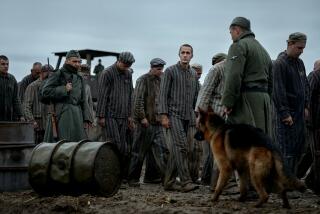Review: The two Syria documentaries you must see to really understand what the hell is going on there
In a scene from the documentary film “Last Men in Aleppo,” a Syrian civilian rescue squad known as the White Helmets rushes to a bombed-out apartment building on a residential street in Aleppo.
Often the squad’s job is retrieving bodies or body parts from destroyed flats, hospitals, bakeries or other civilian structures targeted by President Bashar Assad’s forces or his recent allies, the Russians.
But this day, as rescuer Mahmoud furiously digs through rubble, he uncovers a sign of life. A tiny hand reaching from beneath layers of broken concrete and rubble. Soon three young boys, bloodied, limp, covered in white dust like ghosts, are pulled out alive. Their mom and other siblings — including a baby still in diapers -- weren’t as fortunate.
It’s war, brutal and graphic. You may question: Do I really need to see this? The answer comes in a following scene.
Mahmoud visits the surviving boys and their father a week later.
While the adults talk, the boy who’s no older than 6 sneaks across the room. He sits on the floor next to Mahmoud, burrowing his small frame under his hero’s arm.
The child waits until the others aren’t listening and whispers: “Sir, how did you get me out?”
Mahmoud hugs him.
The boy persists: “I was really tired when you got me. Sir, how did you know I was there?”
“Because you were a flower,” replies Mahmoud. “You needed to see the light.”
Syria. It’s complicated. That’s the easy answer in the waning American conversation about a 6-year-old civil war that’s taken close to half a million lives.
It’s like a bar fight, where all a sudden everyone’s jumped in and is throwing chairs at each other.
— “Hell on Earth’s” Sebastian Junger on Syria’s civil war
Like the war in Iraq that led to the one in Syria that led to a global refugee crisis that fed the Islamic State’s rise, it’s a conflict and humanitarian disaster the West pays attention to only sporadically.
But two new feature documentary films this month are reminders that the Syrian crisis is kids with kid-like questions, volunteers who risk it all for them, power-hungry despots, colluders and terror factions who thrive when the rest of the world turns its back. Both films, which open in theaters this week, will also air on TV — “Hell on Earth: The Fall of Syria and the Rise of ISIS” on the National Geographic Channel June 11 and “Last Men in Aleppo” on PBS July 10.
Syrian filmmaker Feras Fayyad’s “Last Men in Aleppo” is a tightly focused, on-the-ground account of three men who serve in the White Helmets. It’s pure reportage, no narration, no expert voices. It chronicles two years in the lives of embattled rescuers Mahmoud, Khaled and Subhi, all of whom constantly weigh the safety of their own families with their allegiance to serve the people of Aleppo.
As you watch the 104-minute film, it becomes eerily clear that some of the men and women on screen are likely ghosts by now, consumed by the conflict they sought to protect others from. It’s raw, powerful, moving and candid. This is what it is like to be on the ground in Aleppo.
Sebastian Junger’s “Hell on Earth: The Fall of Syria and the Rise of ISIS” is a bigger budget, comprehensive look at the demise of Syria — from the Arab Spring to the Islamic State to the recent involvement of Russia.
The 100-minute film does a phenomenal job detangling the numerous scenarios that led to Syria’s civil war and current bloodbath, dispelling the notion that this conflict is too complicated for those not versed on the Middle East to understand.
The National Geographic Documentary Films’ feature from Junger and Nick Quested (both of whom worked on “Restrepo,” “The Last Patrol” and “Korengal”) utilizes new and old footage, narration by Junger and interviews with Syrian refugees, Aleppo citizens, former Assad soldiers, IS members and U.S. leaders like Arizona Sen. John McCain to demystify the chaos.
“Every Arab Spring was explicitly an anti-corruption demonstration,” explains one expert in the film’s early moments. Syria was no different when its uprising started in 2011. Middle-school kids wrote on a wall protesting the rule of Assad. They were imprisoned and tortured. Protests ensued.
The film asserts that Assad knew what happened to leaders in other countries where the Arab Spring had blossomed (Egypt’s Hosni Mubarak was ousted and thrown in prison), and responded with maximum force. The footage of his troops spraying unarmed protesters with massive amounts of gunfire is horrifying. And the violence escalates from there.
‘Sir, how did you know I was there?’ ‘Because you were a flower,’ replies Mahmoud. ‘You needed to see the light.’
— Scene from ‘Last Men in Aleppo‘
On the world stage, Assad portrayed the battle as one against him and extremist Muslim forces. But in the documentary, journalists who covered the war recount when Assad released dangerous jihadis from prison in hopes of them joining the war and causing more diversionary chaos.
Says narrator Junger: “One of the problems of letting civil war go on for so long is that more and more people get involved. It’s like a bar fight, where all a sudden everyone’s jumped in and is throwing chairs at each other. Syria became a civil war in response the violence of the government, but eventually Iran got involved through Hezbollah to support the Assad regime; the Kurds, Turkey, the Arab Gulf states got involved. … Eventually all the world powers and all the regional powers had some investments in Syria. Once you get a proxy fight, with so many powers, so huge interests in the outcome, it’s almost impossible to stop.”
Enter the Islamic State, who sought to create its own continuous Sunni Muslim caliphate. Its leadership preyed on sectarian tension, say former villagers, taking over entire towns, instituting a barbaric strain of sharia law (public beheadings aren’t shown in their entirety here, thankfully, but ghoulish displays of bodies hung from street lamps are).
Families who were targeted by Assad recount how they were now required to serve the Islamic State or die.
The film follows one such family in its attempt to flee, video shot under the tarp where they all hid, disguised as cargo in the back of a truck as it crossed the border into the safety of Turkey. The film connects them with a refugee crisis so big it’s poured over into Europe, inciting right-wing nationalist movements. And, of course, the lone wolf, IS-inspired terror attacks that have followed in places like Toulouse, France, and San Bernardino.
McCain explains the entry of the Russians into the conflict is “to control areas of Syria of importance to Assad. … People can’t defend themselves from bombardments. Assad wants people in the middle eliminated so the choice is either him or ISIS.”
In “Last Men in Aleppo,” the rescuers of the White Helmets claim allegiance to neither faction. They race to the scenes of destruction perpetuated by both sides in sputtering old ambulances and trucks with rusty radiators that overheat.
“Are you leaving Aleppo?” one man asks another after a run, as they sit in a freezing-cold flat, warming themselves over a kerosene burner.
“Yes,” says the other.
“Where to?”
“The cemetery,” he jokes.
Later, in a more serious moment, rescuer Khaled explains why he’s staying in a place that will eventually kill him.
“Some people prefer to die than live in refugee camps,” he says. “Where can we go? This siege is our destiny.”
‘Hell on Earth: The Fall of Syria and the Rise of ISIS’
Rating: R for some disturbing violent images
Running time: 1 hour, 40 minutes
Playing: Laemmle Monica Film Center; premieres on National Geographic Channel June 11
‘Last Men in Aleppo’
In Arabic with English subtitles
Not rated
Running time: 1 hour, 44 minutes
Playing: Laemmle Music Hall, Beverly Hills’ premieres on PBS July 10
See the most-read stories in Entertainment this hour »
Movie Trailers
ALSO
Roger Ailes turned television news into an Us vs. Them free-for-all
Netflix’s new true-crime series, ‘The Keepers,’ is no ‘Making a Murderer,’ it’s better
From Anderson Cooper’s eye roll to Chuck Todd’s ‘Wow’: The media react to Comey firing
The second season of ‘Master of None’ features a complicated relationship with pork
More to Read
Only good movies
Get the Indie Focus newsletter, Mark Olsen's weekly guide to the world of cinema.
You may occasionally receive promotional content from the Los Angeles Times.











